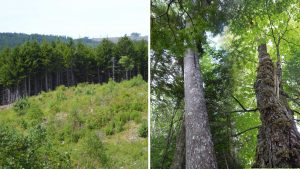Jamie Simpson contends that clearcutting has “borealized” much of the Nova Scotian forest; it’s a concept accepted by at least some federal forestry scientists but not by NSDNR

Two woodlots in Nova Scotia, one involving clearcut forestry and promoting softwoods, the other involving selection management and maintaining a mixed, multi-aged Acadian forest.
Our legacy of past land-clearing for agriculture and our current use of widespread clearcutting has created conditions very favourable to boreal forest tree species {“borealization”], and indeed boreal forest species have flourished at the expense of our warmer-climate adapted trees. We have put our forests in an extremely vulnerable position. Even without climate change, we’ve created forests that are susceptible to greater damage from disease, insect outbreaks and windstorms. Add climate change and we may well witness a “perfect storm” of stresses on large areas of our forest.
“How might we manage our forests if the future (and our children) mattered?” ask Simpson. His answer:
We’d encourage forest harvesting and silviculture practices that favour trees that are at the northern end of their range (rather than encouraging those at the southern end of their range, as we are doing now). This means less clearcutting and more partial cutting methods. It means adopting thinning practices that favour our southern species and forests with a diversity of tree ages growing together. This is not an impossible thing to accomplish. I’ve seen it done by progressive foresters on numerous woodlots in the span of a couple of decades.
Read more in OPINION: Bad forestry practices compound climate challenge (CH, Nov. 3, 2017)
It’s hardly the first time we have heard the message Jamie Simpson delivers but, it seems, it still needs to be repeated.
Natural Resources Canada forester Peter Salonius laid it all out pretty clearly in 2007:
Silvicultural Discipline to Maintain Acadian Forest Resilience
Peter Salonius 2007. Northern Journal of Applied Forestry 24(2): 91- 97.
ABSTRACT: Clearcut harvesting decreases structural complexity, eliminates old and genetically superior legacy trees, extirpates mature-forest floor vegetation, and creates hot and dry postharvest microclimates. The short-lived, exposure-tolerant, boreal tree species that regenerate in large forest openings are believed to be less able, than the late-successional Acadian species they replace, to adapt to the climate warming expected during the next forest rotation. A strip silviculture design is presented that includes limited canopy opening, “no-traffic” areas, maintenance of “full-cycle” survivors, and programmed return harvest intervals that approximate natural gap disturbance as a means of arresting the further increase of boreal species and restoring Acadian species on the landscape. Within the confines of this silvicultural discipline, two management options are described to accommodate extremes of future energy availability.
(The full article is freely available.)
NSDNR does not agree with the concept that clearcutting has effectively “borealized” a lot of what was once multi-aged Acadian forest:
Question 15: Does NSDNR accept the concept that clear-cutting has effectively “borealized” [29] a lot of what was once multi-aged Acadian forest, and that this reduces adaptation to climatic warming?
Response: No.
See if you can understand why by looking at NSDNR’s response to Question 15 in NSDNR Responses to Questions from the Halifax Field Naturalist Submission of April 19, 2017. (I can’t.)
